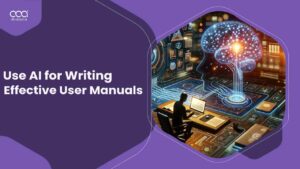In the rapidly advancing ground of technology, artificial intelligence (AI) stands out as a transformative force, particularly in the field of policy-making. By integrating best AI writing tools in France into the creation of policy papers, the traditional and sometimes laborious process is revolutionized, becoming significantly more efficient, precise, and insightful.
AI’s ability to process vast datasets, analyze complex patterns, and generate coherent narratives enhances the clarity and effectiveness of policy papers. This guide explores how to write effective policy papers with AI writing tools in France, emphasizing its role in improving decision-making processes and facilitating more strategic and clear communication within organizations and governments.
How to Write Effective Policy Papers with AI Writing Tools in France – Step-by-Step Guide
This comprehensive guide explores the integration of AI writing tools in crafting effective policy papers, offering step-by-step instructions to enhance clarity, precision, and impact in policy communication.
Step 1: Define the Policy Issue
Clearly identify and articulate the policy issue you intend to address. A well-defined issue will guide your research and argumentation throughout the paper.
Practical Example:
I needed to address urban sustainability in my policy paper. I asked Chatgpt, “Define key concerns in urban sustainability for policy development.” The AI provided a succinct overview, which I used to focus my paper on specific sustainability challenges in urban settings.

Step 2: Conduct Comprehensive Research
Utilize AI tools to gather extensive data, statistics, and existing literature on your chosen policy issue. This step ensures your paper is grounded in solid evidence and current knowledge.
Practical Example:
To deepen my understanding, I prompted ChatGPT, “Summarize recent research findings on urban sustainability practices.” The AI compiled current and relevant research, which I used to back my arguments and recommendations.

Step 3: Analyze Policy Alternatives
Analyze different policy options using AI. Evaluate their potential impacts, feasibility, and implications to present well-rounded recommendations in your paper.
Practical Example:
I needed to compare various sustainability initiatives. I asked ChatGPT, “Analyze the effectiveness of green roofing versus urban parks in enhancing urban sustainability.” The tool provided a comparative analysis, which I incorporated into the policy alternatives section.
Step 4: Structure Your Paper
Develop a clear structure for your policy paper, including an introduction, problem analysis, policy alternatives, recommendations, and conclusion. AI can help outline and organize these sections coherently.
Practical Example:
I requested ChatGPT, “Create an outline for a policy paper on urban sustainability.” The AI suggested a structured outline that included all critical sections, guiding me in organizing my content logically.

Step 5: Draft the Paper
With the research and structure in place, use AI to help draft your paper. AI can assist in generating content for various sections, ensuring clarity and coherence throughout.
Practical Example:
For the recommendations section, I asked ChatGPT, “Draft recommendations for urban policymakers on implementing green roofs.” The AI-generated a draft with clear and actionable recommendations, which I fine-tuned for my paper.

Step 6: Refine and Edit
Refine your draft to enhance its persuasiveness and readability. AI tools can suggest improvements in language, flow, and argumentation to strengthen your paper.
Practical Example:
I reviewed the draft and felt the argumentation needed strengthening. I asked ChatGPT, “Suggest ways to enhance the persuasive power of my policy recommendations.” The AI provided tips on bolstering my arguments, which I integrated into the paper.

Step 7: Validate Citations and References
Ensure all your citations and references are accurate and correctly formatted. AI can assist in checking your citations against original sources and suggesting corrections if needed.
Practical Example:
To ensure citation accuracy, I asked ChatGPT, “Verify the citations in my policy paper and suggest any necessary corrections.” The AI helped identify discrepancies and provided suggestions for correction, ensuring my references were reliable and correctly formatted..

Step 8: Final Review and Submission
Conduct a final review of your paper to ensure it’s polished and ready for submission. AI can assist in this final check, ensuring clarity, coherence, and compliance with submission guidelines.
Practical Example:
Before submission, I requested ChatGPT, “Perform a final review of my policy paper, focusing on clarity and adherence to submission guidelines.” The AI’s feedback helped me make last-minute adjustments, ensuring my paper was ready for submission.

What Are Policy Papers and Why Are They Important?
Policy papers are crucial documents that influence decision-making within organizations or governmental bodies. They serve as comprehensive guides that analyze complex issues, offer recommendations, and outline strategic action plans, all rooted in in-depth research.
The essence of policy papers lies in their ability to inform and shape key decisions, ensuring that such decisions are backed by solid evidence and strategic foresight, thereby guiding stakeholders and policymakers toward informed and effective outcomes.
Significance in Organizational Settings
Effective policy-making in organizational settings is pivotal for guiding decision-making, ensuring compliance, and shaping the overall culture and performance of the institution.
Decision-Making:
Policy papers are the cornerstone of informed decision-making processes, aligning organizational or governmental actions with overarching objectives and providing a solid analytical foundation for those actions.
Communication:
As pivotal communication tools, policy papers elucidate strategies and policies to various stakeholders, fostering alignment, shared understanding, and concerted action.
Guidance:
They offer a structured approach to implementing strategies, ensuring that actions are coherent, focused, and strategically aligned, thus maintaining organizational direction and purpose.
Accountability:
Establishing clear benchmarks and standards, policy papers facilitate performance evaluation and accountability, holding various entities within the organization or government to their commitments.
Adaptation:
In an ever-changing environment, policy papers provide the necessary strategic agility, offering well-defined action plans to navigate and adapt to new challenges or changes effectively.
Significance in Effective Communication and Decision-Making
Policy-making plays a crucial role in enhancing effective communication and decision-making within organizations, setting clear guidelines and expectations, and fostering a coherent and aligned operational framework.
Clarity:
The clarity and coherence of policy papers are fundamental, ensuring that the policies are easily understandable and can be effectively implemented and adhered to across the organization or by the public.
Evidence-based:
By anchoring policies in data and rigorous analysis, policy papers enhance the credibility and reliability of the decisions, ensuring they are defensible and grounded in reality.
Strategic Focus:
These documents play a critical role in aligning immediate actions with broader strategic goals, ensuring consistency and long-term focus in decision-making.
Stakeholder Engagement:
Effective policy papers consider and integrate diverse perspectives, promoting inclusive decision-making processes that take into account the views and needs of all relevant stakeholders.
Change Management:
They are instrumental in managing and guiding organizational or societal change, providing clear, actionable roadmaps that help stakeholders navigate transitions smoothly.
How to Write Effective Policy Papers with AI Writing Tools in France – Key Advancements
AI has significantly transformed policy writing, introducing speed, accuracy, and a new level of analytical depth. Discover the latest breakthroughs in AI technology that are revolutionizing policy writing, offering unprecedented precision and efficiency.

Data Processing:
AI excels in processing extensive datasets quickly and accurately, enabling the extraction of meaningful insights that inform more nuanced and data-driven policy decisions.
Natural Language Processing (NLP):
By enhancing the clarity, coherence, and readability of policy papers, NLP technologies ensure that the resulting documents effectively communicate their intended messages and strategies.
Predictive Analytics:
AI’s ability to forecast potential outcomes provides policymakers with a strategic advantage, enabling the development of proactive, forward-looking policies that can anticipate and address future challenges.
Automation:
The automation of routine and repetitive tasks in policy writing frees up human analysts to focus on more strategic, complex, and impactful aspects of policy development, enhancing overall productivity and creativity.
Customization:
AI’s adaptability allows for the customization of policy documents to suit different contexts, audiences, or regions, increasing the documents’ relevance, applicability, and impact.
How to Write Effective Policy Papers with AI Writing Tools in France – Examples
Explore practical applications of AI tools in policy writing, showcasing how they transform complex tasks into manageable solutions.
GPT-3:
This advanced AI model assists in creating coherent, contextually relevant policy drafts, reducing the time and effort required for initial drafting and enabling a focus on refinement and depth in policy development.
Data Analysis Tools:
Leveraging AI’s robust analytical capabilities, these tools delve deep into data, uncovering insights that form the backbone of evidence-based policy recommendations, ensuring that policies are not only reactive but also strategically informed.
Automated Research Assistants:
These AI-powered tools streamline the research process, efficiently compiling and summarizing relevant information, which enriches the foundation of policy papers with comprehensive, up-to-date, and relevant data and studies.
Language Models:
Beyond generating text, AI language models enhance the grammatical precision, clarity, and readability of policy documents, ensuring that the policies are communicated effectively and can be easily understood and implemented.
Simulation Tools:
By simulating potential policy outcomes, AI provides policymakers with valuable foresight, enabling the design of strategies that are both effective in the present and resilient in the face of future uncertainties.
How Can AI Tools Enhance Your Policy Writing Process?
AI tools bring a transformative edge to policy writing, not only speeding up the process but also elevating the quality, precision, and contextual relevance of the output.

Customization:
AI’s ability to customize content is invaluable, allowing policy documents to be precisely tailored to the specific contexts and requirements of different organizations or departments. This customization ensures that the policies are not only relevant but also resonant with the intended audience, increasing their effectiveness and applicability.
Collaboration:
AI enhances collaboration by providing platforms and tools that facilitate the seamless integration and synthesis of insights from various stakeholders. This feature is crucial in policy making, where diverse perspectives and expertise contribute to more robust, well-rounded, and inclusive policy documents.
Version Control:
The sophisticated version control offered by AI tools is essential for maintaining the integrity and consistency of policy documents throughout the drafting and revision processes. This ensures that changes are tracked, versions are managed efficiently, and the final document is coherent and consolidated.
Accessibility:
AI tools can significantly enhance the accessibility of the policy writing process, making it easier for individuals with different abilities and from various backgrounds to contribute to or understand policy documents. This inclusivity is vital for creating policies that are equitable and representative of a diverse population.
Feedback Loops:
The ability of AI to provide immediate, automated feedback on the clarity, coherence, and quality of policy drafts is a game-changer. It allows writers to make real-time improvements, ensuring that the documents are clear and concise, and effectively communicate the intended message.
Streamlining the Policy Writing Process:
Learn how AI is simplifying the policy writing process, enabling faster, more accurate, and consistent policy documents.
Efficiency:
AI drastically cuts down the time needed to draft and revise policy documents. By automating routine tasks and generating initial drafts, AI allows policy writers to focus on refining the content and delving deeper into complex analyses, thereby speeding up the entire process.
Consistency:
Ensuring consistency in language, style, and format across multiple policy documents can be challenging. AI tools can automate these aspects, maintaining a uniform tone and style that aligns with the organization’s standards and improves the documents’ readability and professionalism.
Accuracy:
The accuracy of data analysis and interpretation is crucial for making informed policy recommendations. AI enhances this accuracy by leveraging advanced algorithms and machine learning models to analyze data, identify trends, and generate insights that are free from human error or bias.
Engagement:
AI tools can also play a pivotal role in determining how policy papers are received by their audience. By suggesting engagement strategies and optimizing the content for different platforms or audiences, AI ensures that the policies not only reach their intended audience but also resonate and drive action.
Innovation:
AI fosters innovation in policy development by introducing cutting-edge technologies and methodologies. It opens up new avenues for analyzing data, predicting trends, and exploring alternative scenarios, thereby encouraging creative and forward-thinking approaches to policy formulation.
How to Ensure Your AI-Written Policies Are Effective and Compliant?
The effectiveness and compliance of AI-written policies are crucial for their success and organizational adoption. Addressing these aspects involves several key considerations:
Validation:
Regularly validate AI-generated content against current laws, regulations, and internal compliance frameworks to ensure that policies remain relevant and enforceable.
Stakeholder Feedback:
Incorporate a mechanism for collecting and analyzing feedback from policy users and stakeholders using AI, ensuring the policy is practical and meets the needs of its audience.

Transparency:
Maintain transparency about the use of AI in policy development, clarifying where and how AI was used to build trust and understanding among stakeholders.
Ethical Considerations:
Actively monitor and audit AI tools for bias or ethical issues, ensuring that policies are fair and do not inadvertently discriminate or cause harm.
Continuous Learning:
Utilize AI’s learning capabilities to refine policies over time, adapting to new information, changing conditions, or feedback to keep policies relevant and effective.
What Are the Common Challenges in AI-Powered Policy Writing and How to Overcome Them?
Despite the benefits, AI-powered policy writing can encounter specific challenges that need to be addressed proactively:
Bias:
AI systems can perpetuate or amplify biases present in their training data. Counter this by using diverse data sets and regularly auditing AI outputs for bias.
Complexity:
The complexity of AI algorithms can make them opaque and difficult to understand. Combat this by using explainable AI models and providing clear documentation and rationales for AI-generated recommendations.
Integration:
Integrating AI into existing policy development processes can be challenging. Facilitate this by designing user-friendly interfaces and providing training for staff.
Security:
AI systems can be vulnerable to data breaches or misuse. Ensure robust data security protocols and monitor AI systems for any signs of unauthorized access or anomalies.
Skill Gaps:
There may be a gap in the necessary skills among staff to effectively use AI tools. Address this through targeted training programs and the inclusion of multidisciplinary teams in the policy development process.
How to Write Effective Policy Papers with AI Writing Tools in France – Future Trends
The trajectory of AI in policy writing points to several future trends:
Greater Personalization:
AI will enable policies to be more tailored to specific contexts, departments, or individuals, increasing their effectiveness and relevance.
Enhanced Predictive Capabilities:
Future AI tools will offer even more sophisticated predictive insights, allowing organizations to anticipate and prepare for potential challenges or opportunities.
Collaborative AI:
We can expect AI to facilitate greater collaboration in policy development, enabling more participatory approaches and integrating diverse perspectives.
Ethical AI:
The focus on ethical AI will intensify, ensuring that AI-generated policies are fair, unbiased, and promote inclusivity.
Augmented Decision-Making:
AI will increasingly serve as a partner in decision-making, providing data-driven insights and recommendations to complement human expertise and intuition.
FAQs
Here are some of the most commonly asked questions about how to write effective policy papers with AI writing tools in France.
Can AI write policies?
How is AI used in policy making?
How will AI affect public policy in France?
Can ChatGPT write policies and procedures?
Conclusion
The integration of AI into policy writing and making marks a significant advancement in how decisions are informed and strategies are formulated. AI’s role in analyzing data, predicting trends, and generating initial drafts can greatly enhance the efficiency and effectiveness of policy development.
In this article, we have comprehensively discussed how to write effective policy papers with AI writing tools in France and everything related to it in detail. To learn more about the usage of AI writing tools in different arenas, check out more articles in our how-to guides. You can also enhance your understanding of AI terms by visiting our AI glossary.





